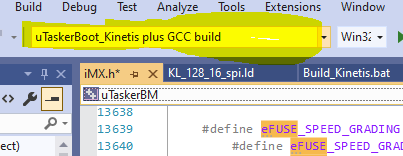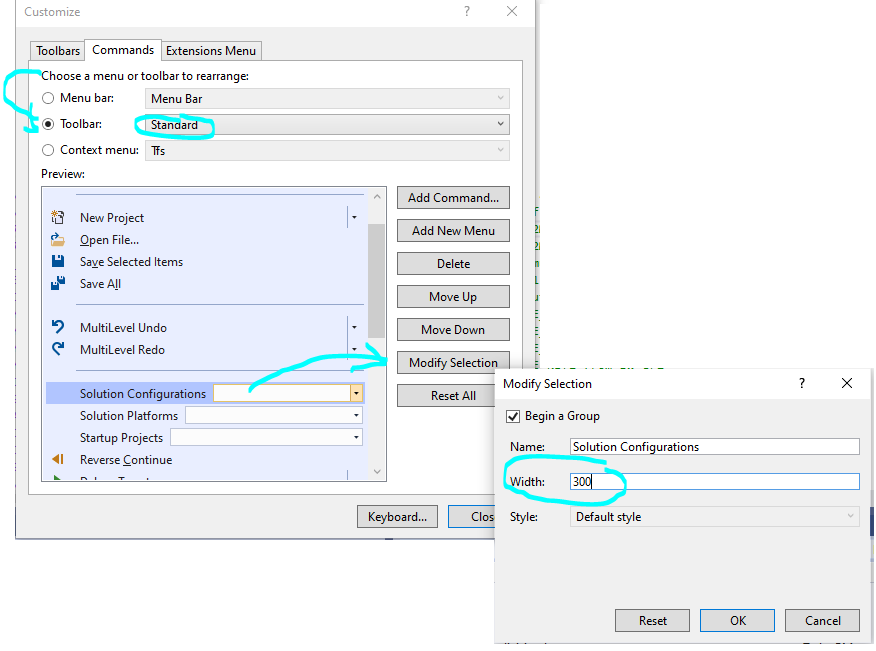1
NXPTM M522XX, KINETIS and i.MX RT / Tips when building Loader with MCUXpresso (especially for i.MX RT 1064)
« on: June 18, 2024, 03:26:09 PM »
Hi All
Here are a few Q.A.s relevant to building the loader using MCUXpresso, especially when building for the i.MX RT 1064 (which has internal QSPI flash at the address 0x7000 0000 instead of the typical 0x6000 0000, used by external QSPI flash (and also the internal QSPI in the i.MX RT 1024).
Note that the full instructions can be found in the document: https://www.utasker.com/docs/iMX/MCUXpresso.pdf
The details in the document are believed to be complete and accurate and if followed to the letter there should be no issues but deviating based on assumptions that things should be a little different may lead to failure to obtain a bootable image and so modifying details should be avoided to be sure of quick success.
>>The config.h files have the wrong target set - how does it still work for my target, the i.MX RT 1064?
This pre-processor define for the target board is delivered as an environment variable when building with MCUXpresso and the value in the config.h files is not used (it is greyed out by MCUXpresso when viewed in its editor) and is only used when building with methods that cannot be better automated (such as the VS bat file method which uses the values in the headers and so needs them all set to match).
IMPORTANT: when setting the environment variables they must be set for "All configuration" so that the single setting is valid for all. Never change for just one single target configuration!!
>> The properties in the MCUXpresso properties are for the the wrong processor - why does it still work?
The target is not important for building since the compiler is the same for all ARM7s. It is only relevant when debugging so that the debugger presents the correct peripheral registers view (if ever used). It won't harm setting to match the exact chip but is usually not needed.
>>I use a processor with double-precision processor but the project is set for single-precision - why does it still work?
The FPU is probably not used by the loaders (as there is no calculations in the code that need it) and it could be set to single, double or SW to result in the same outcome on most parts (if optimised for the processor's capabilities calculations using FPU may be slightly faster but wouldn't be noticeable).
This is left by default at "single" so that it run on the i.MX RT 1011 as well (which has single precision HW). If it were set to double as default there could be an issue for i.MX RT 1011 users in case the compiler did make use of the FPU and it could result in such users experiencing hard-faults when the code tried to execute if this setting were not explicitly set to single or SW methods.
Since the FPU setting and use is not really relevant it is simpler to just default to single so it can always be used successfully and not cause potential loss of time if were an exception needed by just some.
If the target processor has double precision FPU it can of course be set to that.
>> The uTaskerBoot linker is set to to iMX_RT_1064_FlexSPI_NOR.ld as per the instructions but the loader fails.
The 1064 has one single exception due to its internal memory layout and that is to set this file ONLY to the BM-loader. The serial loaders are linked to run in RAM (so that they can program the Flash) and so ALWAYS (irrespective of the processor) MUST be left as iMX_RT_10XX_FlexSPI_NOR_BOOT.ld. This locates to RAM and doesn't use Flash - therefore its flash setting (0x6000 0000) is not relevant and is left as the one that matches the majority of processors.
The names of the linker scripts reflect their intention
iMX_RT_1064_FlexSPI_NOR.ld <- 1064 means specifically for this part
iMX_RT_1064_FlexSPI_NOR.ld <- NOR means booting/running from NOR flash
iMX_RT_10XX_FlexSPI_NOR_BOOT.ld <- 10xx means suitable for any 10xx part (including 1064)
iMX_RT_10XX_FlexSPI_NOR_BOOT.ld <- BOOT means suitable for operation with the BM-boot loader (i.e. located in RAM)
The BM-loader (primary loader) is configured to use
iMX_RT_10xx_FlexSPI_NOR.ld
by default, which is already suitable for any other i.MX RT 10xx parts and this change is ONLY needed by the i.MX RT 1064.
Regards
Mark
Here are a few Q.A.s relevant to building the loader using MCUXpresso, especially when building for the i.MX RT 1064 (which has internal QSPI flash at the address 0x7000 0000 instead of the typical 0x6000 0000, used by external QSPI flash (and also the internal QSPI in the i.MX RT 1024).
Note that the full instructions can be found in the document: https://www.utasker.com/docs/iMX/MCUXpresso.pdf
The details in the document are believed to be complete and accurate and if followed to the letter there should be no issues but deviating based on assumptions that things should be a little different may lead to failure to obtain a bootable image and so modifying details should be avoided to be sure of quick success.
>>The config.h files have the wrong target set - how does it still work for my target, the i.MX RT 1064?
This pre-processor define for the target board is delivered as an environment variable when building with MCUXpresso and the value in the config.h files is not used (it is greyed out by MCUXpresso when viewed in its editor) and is only used when building with methods that cannot be better automated (such as the VS bat file method which uses the values in the headers and so needs them all set to match).
IMPORTANT: when setting the environment variables they must be set for "All configuration" so that the single setting is valid for all. Never change for just one single target configuration!!
>> The properties in the MCUXpresso properties are for the the wrong processor - why does it still work?
The target is not important for building since the compiler is the same for all ARM7s. It is only relevant when debugging so that the debugger presents the correct peripheral registers view (if ever used). It won't harm setting to match the exact chip but is usually not needed.
>>I use a processor with double-precision processor but the project is set for single-precision - why does it still work?
The FPU is probably not used by the loaders (as there is no calculations in the code that need it) and it could be set to single, double or SW to result in the same outcome on most parts (if optimised for the processor's capabilities calculations using FPU may be slightly faster but wouldn't be noticeable).
This is left by default at "single" so that it run on the i.MX RT 1011 as well (which has single precision HW). If it were set to double as default there could be an issue for i.MX RT 1011 users in case the compiler did make use of the FPU and it could result in such users experiencing hard-faults when the code tried to execute if this setting were not explicitly set to single or SW methods.
Since the FPU setting and use is not really relevant it is simpler to just default to single so it can always be used successfully and not cause potential loss of time if were an exception needed by just some.
If the target processor has double precision FPU it can of course be set to that.
>> The uTaskerBoot linker is set to to iMX_RT_1064_FlexSPI_NOR.ld as per the instructions but the loader fails.
The 1064 has one single exception due to its internal memory layout and that is to set this file ONLY to the BM-loader. The serial loaders are linked to run in RAM (so that they can program the Flash) and so ALWAYS (irrespective of the processor) MUST be left as iMX_RT_10XX_FlexSPI_NOR_BOOT.ld. This locates to RAM and doesn't use Flash - therefore its flash setting (0x6000 0000) is not relevant and is left as the one that matches the majority of processors.
The names of the linker scripts reflect their intention
iMX_RT_1064_FlexSPI_NOR.ld <- 1064 means specifically for this part
iMX_RT_1064_FlexSPI_NOR.ld <- NOR means booting/running from NOR flash
iMX_RT_10XX_FlexSPI_NOR_BOOT.ld <- 10xx means suitable for any 10xx part (including 1064)
iMX_RT_10XX_FlexSPI_NOR_BOOT.ld <- BOOT means suitable for operation with the BM-boot loader (i.e. located in RAM)
The BM-loader (primary loader) is configured to use
iMX_RT_10xx_FlexSPI_NOR.ld
by default, which is already suitable for any other i.MX RT 10xx parts and this change is ONLY needed by the i.MX RT 1064.
Regards
Mark



